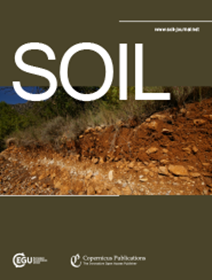Closing the phenotyping gap with non-invasive belowground field phenotyping
IF 4.3
2区 农林科学
Q1 SOIL SCIENCE
引用次数: 0
Abstract
Abstract. Breeding climate-robust crops is one of the needed pathways for adaptation to the changing climate. To speed up the breeding process, it is important to understand how plants react to extreme weather events such as drought or waterlogging in their production environment, i.e. under field conditions in real soils. Whereas a number of techniques exist for aboveground field phenotyping, simultaneous non-invasive belowground phenotyping remains difficult. In this paper, we present the first data set of the new HYDRAS (HYdrology, Drones and RAinout Shelters) open-access field-phenotyping infrastructure, bringing electrical resistivity tomography, alongside drone imagery and environmental monitoring, to a technological readiness level closer to what breeders and researchers need. This paper investigates whether electrical resistivity tomography (ERT) provides sufficient precision and accuracy to distinguish between belowground plant traits of different genotypes of the same crop species. The proof-of-concept experiment was conducted in 2023, with three distinct soybean genotypes known for their contrasting reactions to drought stress. We illustrate how this new infrastructure addresses the issues of depth resolution, automated data processing, and phenotyping indicator extraction. The work shows that electrical resistivity tomography is ready to complement drone-based field-phenotyping techniques to accomplish whole-plant high-throughput field phenotyping.用非侵入性地下场表型缩小表型差距
摘要。培育适应气候变化的作物是适应气候变化的必要途径之一。为了加快育种进程,重要的是要了解植物如何对生产环境中的极端天气事件(如干旱或内涝)作出反应,即在实际土壤的田间条件下。尽管存在许多用于地上田间表型的技术,但同时进行非侵入性地下表型仍然很困难。在本文中,我们展示了新的HYDRAS (HYdrology, Drones and RAinout Shelters)开放式现场表型基础设施的第一个数据集,将电阻率断层扫描、无人机图像和环境监测结合起来,使技术准备水平更接近育种者和研究人员的需要。本文研究了电阻率层析成像技术(ERT)是否能提供足够的精度和准确度来区分同一作物不同基因型的地下植物性状。该概念验证实验于2023年进行,其中有三种不同的大豆基因型,因其对干旱胁迫的不同反应而闻名。我们将说明这种新的基础设施如何解决深度分辨率、自动数据处理和表型指标提取等问题。该研究表明,电阻率层析成像技术可以作为无人机现场表型技术的补充,以实现全株高通量现场表型。
本文章由计算机程序翻译,如有差异,请以英文原文为准。
求助全文
约1分钟内获得全文
求助全文
来源期刊

Soil
Agricultural and Biological Sciences-Soil Science
CiteScore
10.80
自引率
2.90%
发文量
44
审稿时长
30 weeks
期刊介绍:
SOIL is an international scientific journal dedicated to the publication and discussion of high-quality research in the field of soil system sciences.
SOIL is at the interface between the atmosphere, lithosphere, hydrosphere, and biosphere. SOIL publishes scientific research that contributes to understanding the soil system and its interaction with humans and the entire Earth system. The scope of the journal includes all topics that fall within the study of soil science as a discipline, with an emphasis on studies that integrate soil science with other sciences (hydrology, agronomy, socio-economics, health sciences, atmospheric sciences, etc.).
 求助内容:
求助内容: 应助结果提醒方式:
应助结果提醒方式:


